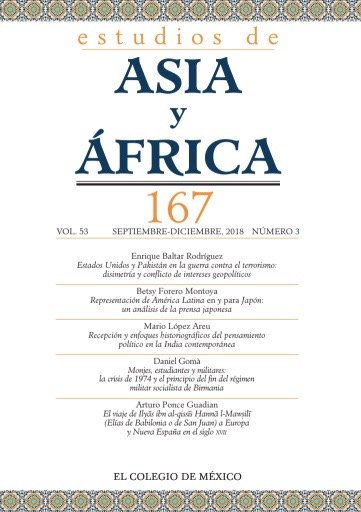Abstract
Often reduced to the footnotes of contemporary research on Burma, the events of 1974 were crucial in the country’s recent his-tory and subsequent political development. The anti-government protests were violently crushed by the army but marked the first major evidence of the difficulties facing the ‘Burmese Way to Socialism’, a revolutionary and utopian military experiment developed since 1962, and the precedent of the 1988 revolution that would end General Ne Win’s military regime.References
Arumugam, R. S. (1975). Burma: A political and economic background. Southeast Asian Affairs, 41-48.
Burma (1977). Asia Yearbook 1976 (pp. 121-127). Hong Kong: Far Eastern Economic Review.
Cady, J. F. (1976). The United States and Burma. Cambridge, MA: Harvard University Press.
Charney, M. W. (2009). A history of modern Burma. Cambridge, MA: Cambridge University Press.
Family appeals for government action to safeguard U Thant’s remains. (13 de diciembre de 1974). The Working People’s Daily, p. 2.
Fistié, P. (1985). La Birmanie ou la quête de l’unité: Le problème de la cohésion nationale dans la Birmanie contemporaine et sa perspective historique. París: Publications de l’École Française d’ExtrêmeOrient.
Food dealers arrested (1 de febrero de 1973). Forward, p. 6. General Ne Win’s speech on price increasing. (3 de mayo de 1974). The Guardian, p. 2.
Government of Burma. (1973). Long-term and short-term policies of the Burma Socialist Programme Party. Rangún: Ministry of Planning and Finance.
Government of the Socialist Republic of the Union of Burma (1974). The Constitution of the Socialist Republic of the Union of Burma. Rangún: Ministry of Information. Recuperado de http://www.burmalibrary.org/docs07/1974Constitution.pdf
Government of the Socialist Republic of the Union of Burma (1975). Report to the Pyithu Hluttaw on the financial, economic and social conditions of the Socialist Republic of the Union of Burma. Rangún: Ministry of Planning and Finance.
Kyaikkasan and Shwedagon. (10 de diciembre de 1974). The Guardian, p. 2.
Martin, E. W. (febrero de 1975). The Socialist Republic of the Union of Burma: How much change? Asian Survey, 15(2), 129-135. https://dx.doi.org/10.2307/2643323
Mendelson, E. M. (1975). Sangha and the State in Burma: A study of monastic sectarianism and leadership. Ithaca, NY: Cornell University Press.
Mya, M. (1992). Totalitarianism in Burma: Prospects for economic development. Nueva York: Paragon House.
Ne Win’s address on rice issue. (12 de julio de 1974). Working People’s Daily, p. 2.
Peiris, D. (13 de septiembre de 1974). Socialism without commitment. Far Eastern Economic Review, 27-30.
Perry, P. J. (2007). Myanmar (Burma) since 1962: The failure of development. Aldershot: Ashgate.
Proclamation of military administration in Rangoon division, military administration orders. (12 de diciembre de 1974). The Guardian, p. 1.
Seekins, D. M. (2002). Disorder in order: The army and the State in Burma since 1962. Bangkok: White Lotus.
Seekins, D. M. (2006). Historical dictionary of Burma (Myanmar). Lanham, MD: The Scarecrow Press.
Selth, A. (1989). Death of a hero: The U Thant disturbances in Burma, December 1974. Brisbane: Griffith University.
Sensibilities of society spurned (10 de diciembre de 1974). The Working People’s Daily, p. 1.
Silverstein, J. (1977). Burma: Military rule and the politics of stagnation. Ithaca, NY: Cornell University Press.
Smith, M. (1999). Burma: Insurgency and the politics of ethnicity. Londres: Zed Books.
Steinberg, D. I. (1981). Burma’s road toward development: Growth and ideology under military rule. Boulder: Westview Press.
Tun, M. C. (4 de enero de 1973). Out of the frying pan. Far Eastern Economic Review, 18-19.
Tun, M. C. (11 de julio de 1974a). Increasing tension in Burma. Far Eastern Economic Review, 8-10.
Tun, M. C. (4 de octubre de 1974b). A Race against time for Burma’s farmers. Far Eastern Economic Review, 36-37.
U Thant’s Burial at Cantonment Park (8 de diciembre de 1974). The Working People’s Daily, p. 1.
U Thant’s Funeral Arrangements Disrupted (6 de diciembre de 1974). The Working People’s Daily, p. 1.
Wiant, J. A. (1981). Tradition in the service of revolution: The political symbolism of Taw-Hlan-Ye-Khit. En F. K. Lehman (Ed.), Military rule in Burma since 1962: A kaleidoscope of views (pp. 59-72). Singapur: Maruzen Asia.
This work is licensed under a Creative Commons Attribution-NonCommercial-NoDerivatives 4.0 International License
Copyright 2022 Estudios de Asia y África


